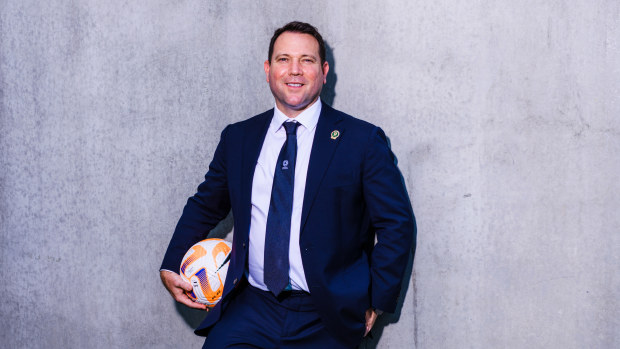Socceroos, Matildas success boosts cash for Football Australia

The Socceroos’ FIFA Men’s World Cup success and the rising popularity of the Matildas generated a 48 per cent increase in revenue during the last financial year for the governing body, Football Australia.
Almost $20 million in prizemoney from the Socceroos’ performance, and a large increase in sponsorship and merchandise sales, delivered total revenue of $113.3 million for the financial year ending June 30, compared with $76.5 million the previous year.

Football Australia chief executive James Johnson after the governing body’s AGM on Wednesday. James Brickwood
The results mean Football Australia has made as much money as it typically did when it received revenue from the national competition, the A-Leagues. The most amount of money Football Australia ever generated before the split of the A-Leagues from the governing body was $132 million – in FY18.
Football Australia chief executive James Johnson said those figures would continue to grow thanks to the Matildas’ historic FIFA Women’s World Cup campaign and the rising popularity of the sport.
“When we had the A-Leagues, the majority of our revenues at Football Australia was coming through them. We’ve effectively replaced the revenue that the A-Leagues was bringing in,” Mr Johnson said.
The increase in revenue was driven by a $20 million prize for the Socceroos’ performance at the World Cup, and a 32 per cent increase in sponsorship from $13.7 million to $20.2 million. Mr Johnson said deals with Subway and Lego were major contributors to the increase. But a $3.1 million boost in funding from grants and $2.1 million increase in money from merchandising also contributed to the growth.
Football Australia’s net surplus was $671,000, compared with a $3.6 million profit the previous year (which included a $7.1 million extraordinary item related to its stake in the Australian Premier League).
Mr Johnson said the sale of Matildas merchandise in the first quarter of the new financial year is already worth more than the $3.1 million total for the previous financial year. The ratio of Matildas merchandise sales to Socceroos is currently two to one.
“We’re confident that sponsorship will continue to rise in FY24,” Mr Johnson said. “The prizemoney for the Women’s World Cup will get recognised in FY24 … and we get a share of the ticket sales of the Women’s World Cup. The Matildas jerseys ... will be recognised in FY24.”
The prizemoney from the Matildas is expected to be smaller than the Socceroos, despite the team performing better. This is because the total prizemoney for the Women’s World Cup paid by FIFA was $US110 million ($167.9 million) compared with $US440 million for the men’s tournament. The Matildas’ prizemoney was $US6.3 million.

The Socceroos applaud the Australian supporters after their close loss to Argentina. The team made $19 million from their second round appearance. AP
Mr Johnson said the growth was proof that the investment in the national football teams on and off the pitch was working. In FY23, Football Australia spent $21.5 million on the Socceroos and $11.6 million on the Matildas. It invested a total of $49.5 million in its national teams, including the ParaMatildas, Pararoos and juniors.
“The rationale from a business standpoint behind those investments is that if you’re building the brand off the pitch, we will see an increase in broadcast sponsorship, match day revenue and merchandise,” he said.
“If we invest in the teams on the pitch, then they would perform … which means we get more prizemoney. ”
Under a newly signed collective bargaining agreement, the Socceroos and Matildas will receive 50 per cent of the prizemoney won at FIFA competitions and a portion of revenue generated from sponsorship, broadcast rights, match day revenue and merchandise.
“We want to bring the players in the tent, we want them to be our partners, and we want them to be responsible for helping us grow our business,” he added.
Mr Johnson said discussions with potential broadcast partners about a new commercial deal, which will run from 2025 to 2028, was ongoing and “very competitive”.
It will offer access to the FIFA Women’s World Cup, the AFC Asian Men’s Cup in 2026, and AFC Asian Women’s Cup in 2027, in addition to qualifiers and friendly matches for the Socceroos and Matildas. Football Australia is expecting a deal to be complete by early next year.
Introducing your Newsfeed
Follow the topics, people and companies that matter to you.
Find out moreRead More
Latest In Sport
Fetching latest articles